Jana Radaković, PhD
 Contact:
Contact:Institute for Nuclear Sciences “Vinča”
Laboratory for nuclear and plasma physics (lab. 011)
Advanced Materials Research Group (former: Hyperfine Interaction Group)
P.O.Box 522
Belgrade
Serbia
Phone: +381 11 3408 601;
Fax: +381 11 3440 100;
E-mail: janar@vinca.rs
Picture was taken by Katarina Ćirić, my dear friend,
an officemate, and a best colleague anyone can wish for!
Institute of Nuclear Sciences “Vinca”, Belgrade, Serbia
Advisors:
Dr. Jelena Belošević-Čavor, Institute of Nuclear Sciences “Vinca”
Prof. Dr. Miljenko Perić, Faculty of Physical Chemistry, University of Belgrade, Full member of Serbian Academy of Sciences and Arts
Faculty of Physical Chemistry, University of Belgarde,
Institute of Nuclear Sciences Vinca, Belgrade, Serbia
Master thesis: «Ab initio theoretical calculations of structure and ground state energy of Hf2Ni intermetallic compound»
May 2008: Diploma in Physical Chemistry
Faculty of Physical Chemistry, University of Belgarde, 2008.
Diploma thesis: «Resonant spectroscopy of II-VI self-assembled quantum dots: Excited states and exciton–longitudinal optical phonon coupling»
Working and research experience
I am a PhD student at the Faculty of Physical Chemistry, University of Belgrade in Serbia. My PhD work was done at the Institute for Nuclear Sciences “Vinča” in a Laboratory for nuclear and plasma physics (popular name is Lab. 011), where I am currently employed as a research assistant. This Institute and Faculty are located in a beautiful city Belgrade, in a wonderful country Serbia, positioned at the crossroads of Central and Southeast Europe.
During my volunteering (June 2008 – November 2009) and working (November 2009 – Present) period I was involved in a research of the fundamental properties of materials that can be used for hydrogen storage; results were published in several scientific articles [1, 3, 4]. With my thesis supervisor Dr. Jelena Belošević-Čavor I was studying the local structure, electronic properties, and hyperfine interaction parameters of pure and doped C14 Hafnium and Zirconium Laves-phase compounds [2], as well as the possible spacegroups and impurities site preference of Ti-Pd alloy system [5].
Apart from that, I was conducting a study of modifications that occur in the electronic structure, unit cell and hyperfine interactions after the implementation of Tantalum and Cadmium impurities in the unit cell of HfV2 and ZrV2 intermetallic compounds [6], and hydrogenation of HfV2 C15 Laves phase [7]. From that research I formed my PhD thesis, and defence is anticipated in September 2013.
I have experience of quantum mechanical calculations on periodic solids, which I gained during my work with Wien2k and VASP program packages. I am proficient with both Linux (Red Hat/Ubuntu) and Windows (XP/Vista/7) operating systems, and I am involved in the maintenance of Advanced Materials Research Group (INN “Vinča“) web-page. I am fluent in English, in the process of learning German, and trying not to forget leftovers of Russian, I learned long time ago.
Thesis abstract
(pdf In English)
Subject of my thesis was the investigation of electronic structure, hyperfine interactions and stability of HfV2 and ZrV2 intermetallic compounds, pure or with implemented impurities, as well as the HfV2Hx hydrides (x = 1, 2, 3, 4). Research was conducted by employing the density functional theory as implemented in Wien2k computational code. Research involved physical quantities that are extremely sensitive to the electronic distribution in the near vicinity of the nucleus (electric field gradient, asymmetry parameter…), hence high precision for the calculations of the electron density was required. Therefore, all calculations were done using the all-electron scheme of Wien2k computational code.
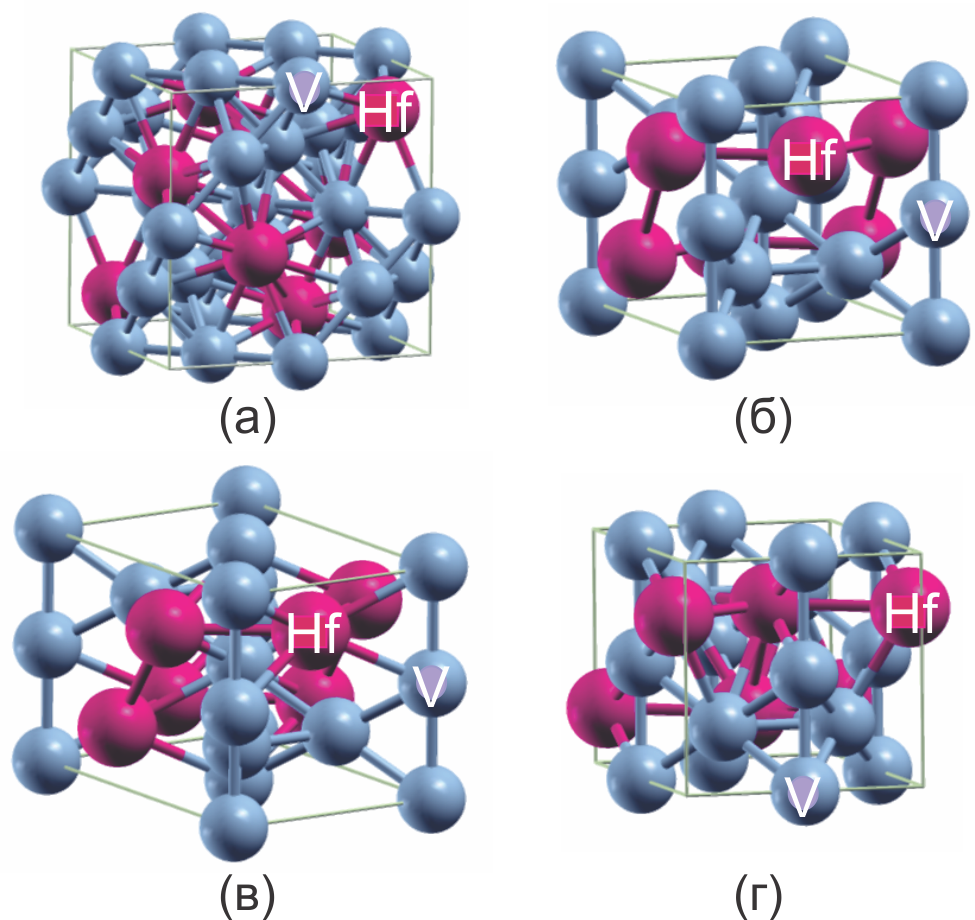
Thesis is divided into two segments. First part consists of the first principles calculations of local structure and electronic properties of three temperature modifications of HfV2 – cubic, tetragonal and orthorhombic – and cubic modification of ZrV2 [6]. Local structure was investigated through the calculations of electric field gradients – numerical value and space orientation – and asymmetry parameters. This physical quantity was investigated on every atomic site in the unit cell of pure compounds, as well as the atomic site of the inserted probe-atom. Computational results were compared with the experimental data from the time differential perturbed angular correlation (TDPAC) and nuclear magnetic resonance measurements. This comparison enabled the determination of the impurity site preference in every examined structure, exact space group of crystals, and crystallographic positions of Hafnium and Vanadium in the low-temperature orthorhombic modification of HfV2.
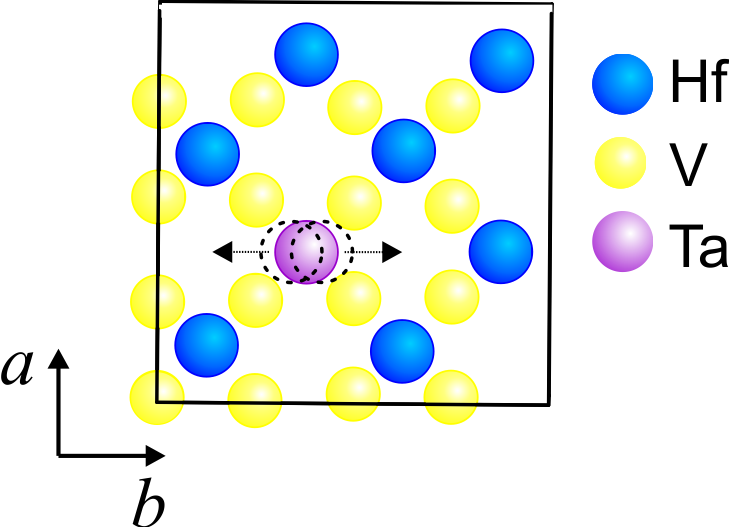
In addition, it was confirmed that the measured, nonzero electric field gradient in the Tantalum-doped cubic HfV2 structure originates from the displacement of Tantalum from its equilibrium position in the cubic environment, and the magnitude of this displacement was established.
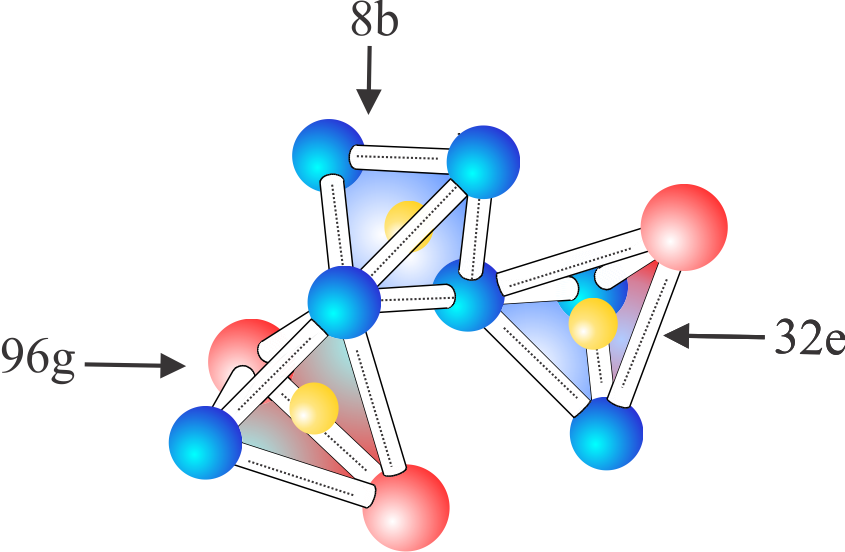
In the second part of the thesis, first principles calculations of the electronic structure, formation enthalpies, and electric field gradients in the cubic hydride HfV2Hx (x = 1, 2, 3, 4) are presented. Modifications of the electronic properties, for example by insertion of hydrogen, induce changes in macroscopic properties, i.e. the formation enthalpy or cohesion energy. Therefore, to understand these physical properties and their chemical consequences, it is of great importance to study the electronic properties of the system before and after hydrogenation. Changes in electronic structure that occur during the diffusion of hydrogen and hydride formation can be studied with electric field gradient, considering its sensitivity of to the electronic structure.
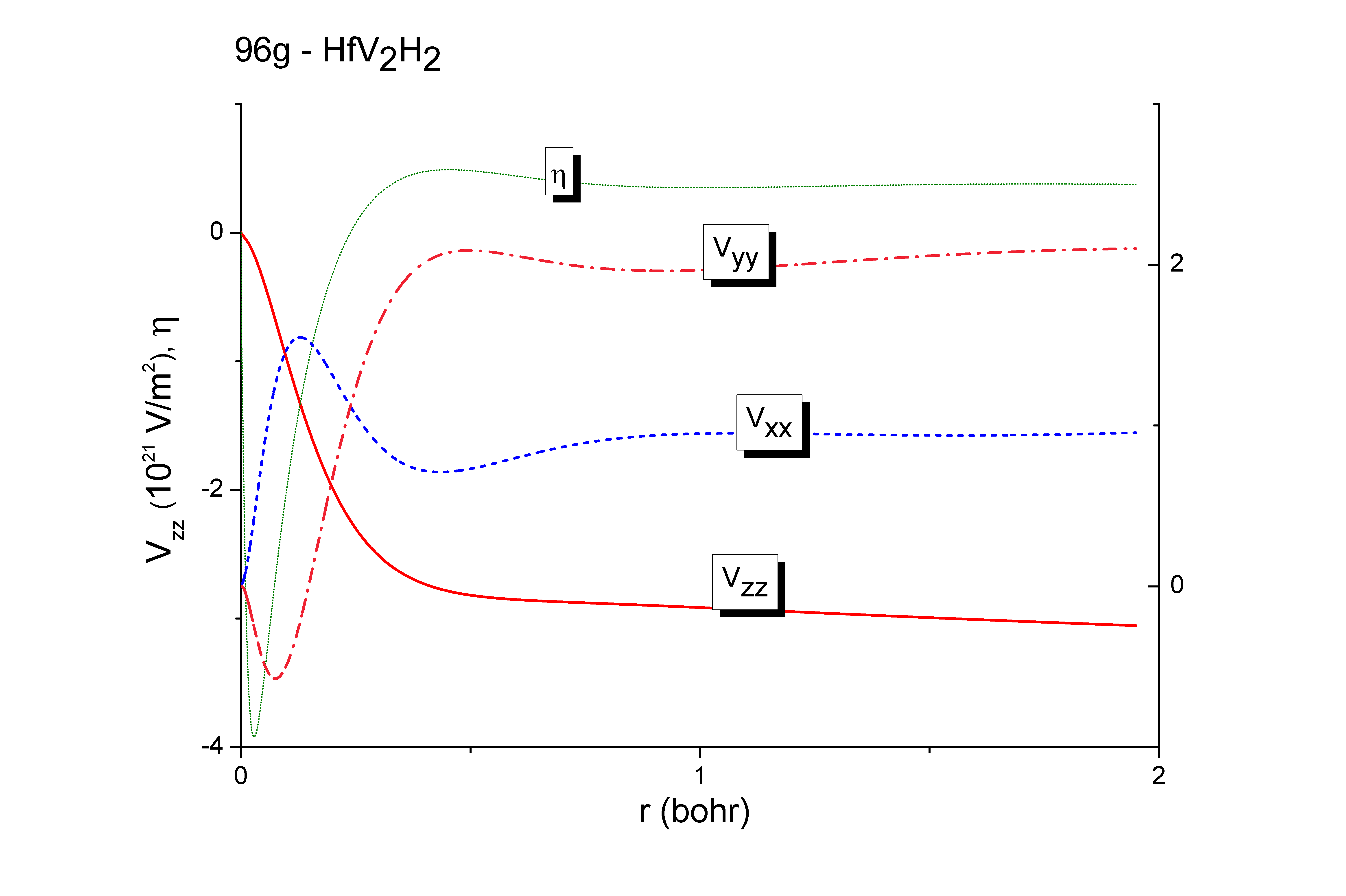
In cubic Laves phases, hydrogen can occupy three possible interstitial positions: 96g, 32e, and 8b. To investigate changes in the electronic structure before and after hydrogenation, and effects that hydrogen implementation has on the unit cell, electric field gradients induced by this atom on the surrounding Vanadium were calculated, and compared with the existing nuclear magnetic resonance measurements. By this comparison, distribution of hydrogen atoms in the crystal lattice, as well as the occupation of possible interstitials was studied.
The formation enthalpy is a good parameter for analysis of the stability of a formed system. By calculating the formation enthalpies of every formed hydride, stability changes that occurred during the hydrogen insertion were investigated.
In addition to this, origin of the electric field gradient on Vanadium in HfV2 hydrides was determined, by investigating the radial distribution functions and distribution of the radial part of electronic density.
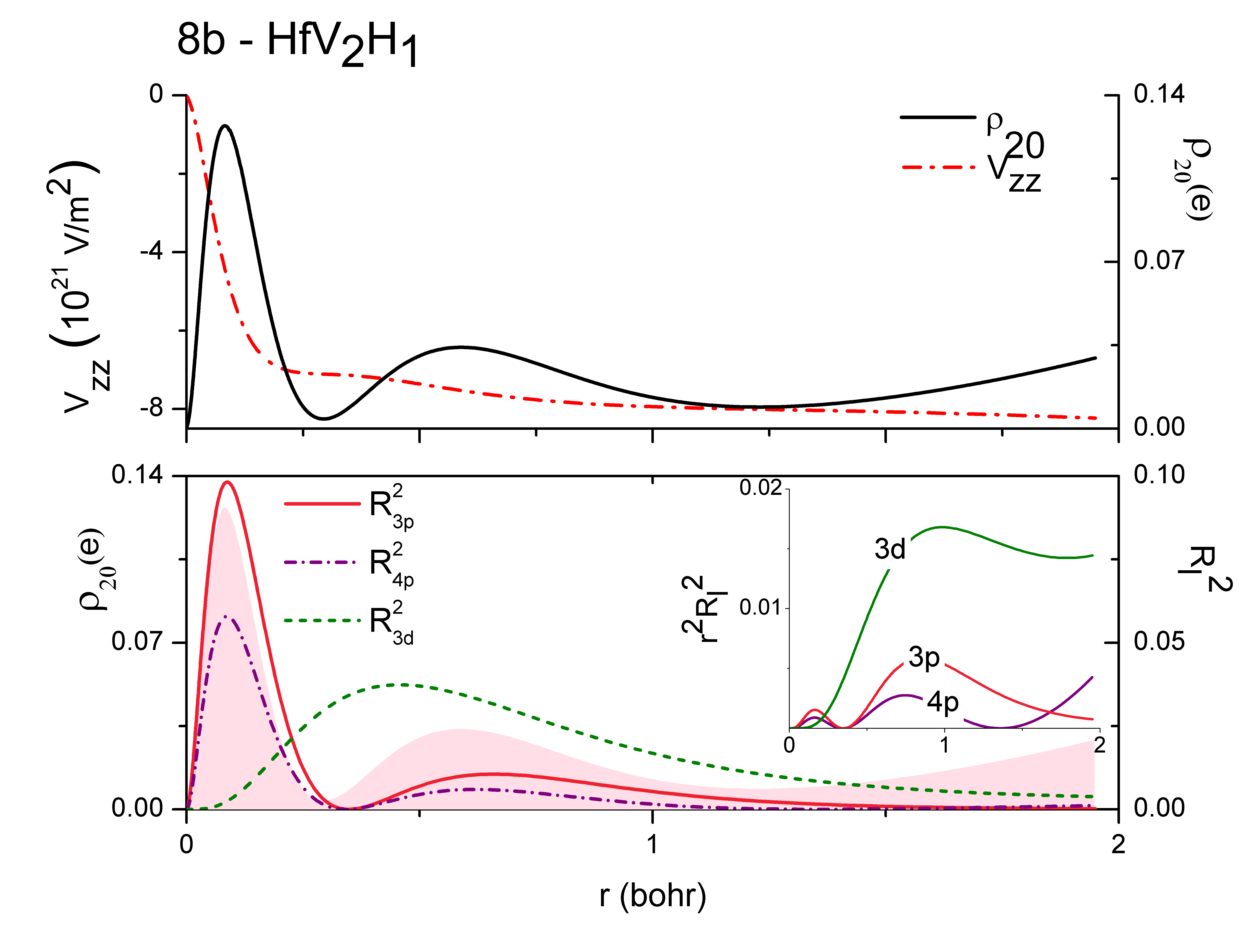
Results of this research can be found in following references [6, 7] listed below.
Publications
- Dragica Stojić, Sandra Kumrić, Jelena Belošević-Čavor, Jana Radaković, Božidar Cekić and Slavko Mentus, International Journal of Hydrogen Energy 34 (2009) 3764-3770
- Jelena Belošević-Čavor, Vasil Koteski, Jana Radaković and Božidar Cekić, Physical Review B 79 (2009) 172407
- Jana Radaković, Katarina Ćirić, Jelena Belošević-Čavor, Vasil Koteski, Computational Material Science 49 (2010) 55-59 (Abstract)
- Katarina Ćirić,Vasil Koteski, Dragica Stojić, Jana Radakovic, Valentin Ivanovski, International Journal of Hydrogen Energy 35 (2010) 3572-3577
- Jelena Belošević-Čavor, Vasil Koteski, Jana Radaković, Solid State Communications 152 (2012) 1072-1075
- Jana Radakovic, Jelena Beloševic-Cavor, Vasil Koteski, Intermetallics 32 (2013) 90-95 (Abstract)
- Jana Radakovic, Jelena Beloševic-Cavor, Vasil Koteski, International journal of hydrogen energy 38 (2013) 9229–9235 (Abstract)
Papers and presentations (pdfs are In Serbian)
Oral and poster presentations
- Poster presentation at Computational Nanoscience for Renewable Energy Solutions, Psi-k summer school, 14-17.09.2009. Helsinki, Finland
Helsinki – selected pictures (CONARES)
- Oral presentation at International Conference on Advanced Materials Modeling and 17th Wien2k workshop, 5-10.07.2010. Institut des Matériaux Jean Rouxel, Nantes, France
Nantes – selected pictures (ICAMM 2010 and 17th WIEN2k)
- Quantum Monte Carlo and Casino Program V Summer School, 01-08.08.2010. Vallico Sotto, Italy
Tuscany – selected pictures (QMC and Casino V)
- Poster presentation at WE-Heraeus Summer School for Physics, Computer Simulations on Nanotechnology for the Environment, 03-15.07.2011. Jacobs University, Bremen, Germany
Bremen, Hamburg – selected pictures (Jacobs University)
- Science and Technology in Cultural Heritage, 05-11.09.2011. Frauenchiemsee, Germany
Frauenchiemsee – selected pictures (STICH 2011)
- Oral presentation at Tenth young researchers’ conference Material Science and engineering, 21-23.12.2011 Belgrade, Serbia
- Poster presentation at 4th International Symposium on Structure-Property Relationships in Solid State Materials, 24-29.06.2012. Bordeaux, France
- Oral presentation (part III) during the working visit to the Department for nanostructured materials, Institute Jožef Štefan, Ljubljana, Slovenia 23-26.09.2012.